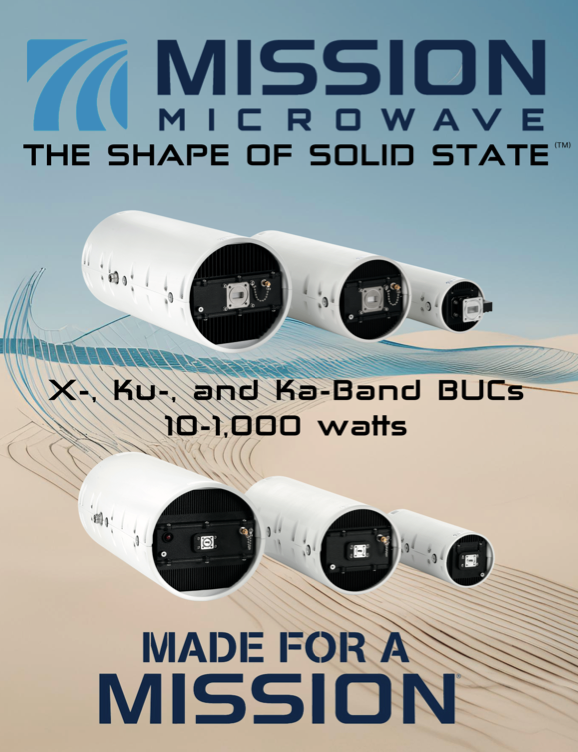Curt Blake, SatNews Senior Columnist, and Sophia Galleher, Associate, both with Wilson Sonsini Goodrich & Rosati
In U.S. communications law, few emerging technologies raise as many jurisdictional questions as space-based optical communications systems. Once a subject of specialized research, laser-based systems now stand at the cusp of commercial maturity. If successfully operationalized, they have the potential to revolutionize data throughput, security, and efficiency—while at the same time testing the jurisdictional reach of the Federal Communications Commission (FCC).

As the U.S. regulator of non-Federal radio spectrum, the FCC has become one of the most important overseers of commercial space activity. No satellite system can realistically gain access to the U.S. market without prior FCC approval and oversight: the agency licenses space and Earth stations and coordinates U.S. filings with the International Telecommunication Union (ITU).
But optical communications systems—particularly optical ground stations—do not fit neatly within the FCC’s statutory authority to regulate communications by “wire or radio.”1 Optical transmissions are not “radio.” Rather, free-space optical communications, or “lasercoms,” use optical wavelengths—generally in the near-infrared portion of the spectrum—to transmit data between user terminals.
The challenge is not simply technical. If optical systems fall outside the FCC’s jurisdictional reach, a significant portion of future space infrastructure could develop without the oversight that has long conditioned U.S. market access for satellite and communications systems. As this technology edges toward maturity, a central question looms: Does the existing U.S. communications regulatory framework—built on the FCC’s authority over communication by “wire and radio”—extend to optical links? Or will these systems force a broader reframing of communications regulation?
This column examines why optical communications may or may not fall outside the FCC’s current purview and considers both the limits of its authority and the potential jurisdictional hooks that the FCC could use to regulate optical systems.
_________________________________________________________________
—The Rise of Optical Communications Technologies—
_________________________________________________________________
Traditionally, satellite communication systems have relied on radio frequency (RF) transmissions within designated spectrum bands to relay signals either between satellites or from satellites to Earth. While these systems remain reliable and widely used, RF spectrum has inherent limitations—most notably finite bandwidth, increasing congestion, and atmospheric attenuation (i.e., signal loss as signals pass through the atmosphere)—that constrain their ability to support higher data throughput. Moving into higher RF bands has helped, but RF systems cannot achieve substantially greater capacity without significant technological advances such as larger antennas or more powerful transmitters.
 Optical communications offer a different path. By transmitting optical wavelengths, typically in the near-infrared range, free-space optical links can provide much higher data rates than RF. National Aeronautics and Space Administration (NASA) estimates that optical communications technologies can deliver up to 40 times the data rates of RF systems.2 Lasercom beams are also narrower than RF beams, which can drastically reduce the potential for interference and increase security by making interception more difficult.
Optical communications offer a different path. By transmitting optical wavelengths, typically in the near-infrared range, free-space optical links can provide much higher data rates than RF. National Aeronautics and Space Administration (NASA) estimates that optical communications technologies can deliver up to 40 times the data rates of RF systems.2 Lasercom beams are also narrower than RF beams, which can drastically reduce the potential for interference and increase security by making interception more difficult.
One key component is the optical ground station. Unlike a traditional RF ground station with a dish antenna, an optical ground station uses a telescope and optoelectronic components to transmit and receive laser signals. These facilities can also be colocated with mission sites or data centers, reducing transmission costs and consolidating operations.
Still, lasercom poses unique technical challenges. The same narrow beam that enhances security also imposes constraints: unlike RF signals that can blanket wide areas, optical links must point directly at a receiver with extreme precision. A deviation of even a fraction of a degree can cause the signal to miss its target altogether. Atmosphere attenuation also remains a major challenge, as atmospheric attenuators such as dust, smoke, fog, haze, and inclement weather impair the technology’s ability to transmit information.
Despite these hurdles, both government programs and industry are investing heavily in optical systems. NASA’s Laser Communications Relay Demonstration, for instance, has tested operational concepts, while commercial operators are increasingly looking to commercialize optical terminals.3
______________________________________________________________
—The FCC’s Expanding Role as a Space Regulator—
______________________________________________________________
Created in 1934 under the Communications Act to regulate “communication by wire and radio,” the FCC has become a central authority in developing and implementing U.S. space regulation. Because nearly all satellites have historically used RF transmissions, the agency has emerged as a de facto regulator of commercial space and satellite operations.4 By licensing spectrum, imposing debris-mitigation conditions, and facilitating international coordination, the FCC has established regulatory guardrails that ensure a predictable framework for private investment and innovation. Although some view its growing role as a regulatory burden, the FCC’s consistency and international stature have also given U.S. companies a competitive edge in navigating global communications policy.5
_____________________________________________________________________________________
— Optical Communications Systems Test the Limits of FCC Authority —
_____________________________________________________________________________________
Optical communications challenge this framework. While the Communications Act grants the FCC clear authority over radio-based satellite links, optical systems operate in a different part of the spectrum—arguably placing them outside the agency’s jurisdiction. Indeed, the FCC has long indicated that it does not have jurisdiction over optical inter-satellite links because they do not involve RF spectrum.6 While that position has not been directly tested with respect to optical ground stations, the prevailing view among U.S. regulators at present is that optical frequencies are unregulated.7 While optical ground facilities may be located in the U.S., their transmissions are not “radio” in the statutory sense.
This distinction matters. If the FCC lacks authority over lasercom, it might be unable to apply licensing requirements, enforce technical standards, or impose other space access conditions such as orbital debris mitigation plans and post-mission disposal requirements. It might also lose a clear basis for participating in international coordination of optical systems, creating a vacuum in how the U.S. engages in global communications policy discussions with respect to optical communications systems.
_____________________________________________________
— Potential Pathways for FCC Oversight —
_____________________________________________________
Although the Communications Act does not expressly cover optical transmissions, the FCC might look for ways to extend its reach. In past contexts, the FCC has interpreted its mandate broadly, sometimes stretching existing tools to cover new technologies. A similar dynamic could emerge with optical communications, where several potential jurisdictional “hooks” might be invoked:
• Ancillary Authority: The FCC has occasionally relied on “ancillary jurisdiction” to regulate activities closely tied to its core responsibilities. The FCC might contend that optical links serve the same function as RF in enabling interstate and international communications, and thus fall within its scope. However, courts have been skeptical of expansive ancillary claims, and any such move would likely face immediate challenge.
• Interference Concerns: Another possibility is for the FCC to step in where optical systems could interfere with scientific or navigational sensors. In this view, oversight would be justified as part of the agency’s broader spectrum-management role.
• Extension by Rule: The FCC could also attempt to extend its existing earth station licensing framework rulemaking, reasoning that optical ground stations are functionally similar to traditional RF facilities even if they use light instead of radio waves.
• National Security Review: A further pathway would be to incorporate optical ground stations into the FCC’s licensing umbrella to facilitate interagency review. Conditions tied to national security or foreign policy are already common in FCC authorizations, and optical oversight could be framed as an extension of that practice.
Each of these pathways would raise its own legal and policy questions, and none would resolve the fundamental statutory gap. For now, the extent of FCC authority over optical systems appears dubious—and any clear mandate would likely require congressional action.
________________________________________________________________
— The Risks and Rewards of Regulatory Ambiguity —
________________________________________________________________
The absence of a clear regulatory framework creates both opportunities and risks for investors and commercial operators. Without immediate licensing obligations or spectrum coordination, industry is freer to experiment with new architectures, deployment models, and product development and commercialization strategies. That flexibility could accelerate development, lower barriers for new entrants, and attract investment by allowing faster deployment of networks and early demonstrations of value.
Internationally, the absence of strict U.S. rules could position U.S. operators to influence standards through practice rather than compliance. Early movers may have the opportunity to set de facto standards by proving the commercial and operational viability of optical systems.
 For policymakers, leaving optical links outside the FCC’s purview may avoid duplication and allow other agencies or industry groups to take the lead on technical standards or best practices.
For policymakers, leaving optical links outside the FCC’s purview may avoid duplication and allow other agencies or industry groups to take the lead on technical standards or best practices.
Uncertainty also carries real risks—operators do not know whether FCC licensing will eventually be required, what conditions might apply, or whether or how the U.S. might ultimately coordinate internationally. Lack of clarity could also complicate global harmonization: other jurisdictions may set their own rules, creating inconsistent standards. In such a scenario, U.S. operators could lose influence in shaping international practices.
For both industry and policymakers, the central question is whether optical communications should be folded into the existing regulatory framework or left outside of it. How that question is answered will shape not only the deployment of this technology but the future trajectory of U.S. space and communications policy with respect to optical spectrum management.
References
1 See 47 U.S.C § 151.
2 NASA, Optical Communications Overview, NASA Technology: Space Communications, https://www.nasa.gov/technology/space-comms/optical-communications-overview/#section-3 (last visited September 25, 2025).
3 See Instituto de Astrofísica de Canarias, Optical Ground Station (OGS), IAC/ESA,iac.es/en/projects/optical-ground-station-ogs (last visited September 15, 2025); NASA-Jet Propulsion Laboratory, Optical Communications Telescope Laboratory (PIA18663), JPL Images, jpl.nasa.gov/images/pia18663-optical-communications-telescope-laboratory/ (last visited September 15, 2025).
4 47 U.S. C § 151; see also Going Once, Going Infinitely, FCC News & Events: Podcast, Federal Communications Commission, fcc.gov/news-events/podcast/going-once-going-infinitely (last visited Sepember 15, 2025).
5 See Federal Communications Commission, FCC Chairman Carr Announces Early Wins at Launch of Satellite Week, News Release (March 10, 2025), docs.fcc.gov/public/attachments/DOC-410075A1.pdf.
6 See Teledesic LLC for Minor Modification of License to Construct, Launch and Operate a Non-Geostationary Fixed Satellite Service System, Order and Authorization, File No. 195-SAT-ML-97 ¶ 14 (1999) (stating “Because optical ISLs do not involve wire or radio frequency transmissions, the Commission does not have jurisdiction over the use of optical ISLs”); see also the Commission’s Table of Frequency Allocations only considers frequencies between 9 kHz and 400 GHz, see 47 C.F.R. § 2.102(a)- optical frequencies are above 400 GHz. The International Telecommunications Union also does not regulate optical inter-satellite links.
7 State-of-the-Art of Small Spacecraft Technology: Communications, NASA § 9.0 (Feb. 5, 2025), nasa.gov/smallsat-institute/sst-soa/soa-communications/ (stating, “at present, optical frequencies are unregulated, unlike RF systems which require a licensing process to be able to communicate with a spacecraft).
wsgr.com
 Finally, without a licensing process, there are fewer mechanisms to ensure safe and secure operation of ground stations. As optical systems proliferate, questions of cybersecurity, physical security, and integration with existing networks will only become more pressing.
Finally, without a licensing process, there are fewer mechanisms to ensure safe and secure operation of ground stations. As optical systems proliferate, questions of cybersecurity, physical security, and integration with existing networks will only become more pressing.

Sophia Galleher
Author Sophia Galleher is an associate in the Washington, D.C., office of Wilson Sonsini Goodrich & Rosati, where she provides strategic, legal, and policy advice to clients navigating the complex and ever-evolving tech and telecommunications regulatory landscape. Sophia’s practice encompasses a wide range of technologies and subject areas, including spectrum allocation, use, and access; U.S. market entry for foreign investors and service providers; ownership limits; broadband affordability, access, and deployment; space and satellite technologies; submarine cables, Artificial Intelligence (AI) governance, content moderation, and platform accountability; the Digital Millennium Copyright Act (DMCA); and other emerging technologies regulation.

Curt Blake
Author Curt Blake, Senior Columnist to SatNews Publishers, is Senior Of Counsel at Wilson Sonsini Goodrich & Rosati. He is an attorney and senior executive with more than 25 years of experience leading organizations in high-growth industries— and more than 10 years as the CEO of Spaceflight, Inc.—at the forefront of the New Space revolution. Curt has extensive expertise in strategic planning, financial analysis, legal strategy, M&A, and space commercialization, with deep knowledge about the unique challenges of New Space growth and the roadmap to success in that ecosystem.
The views expressed in this article reflect those of the authors themselves and do not necessarily reflect the views of their employer or their clients.

